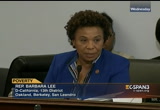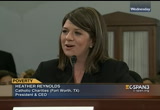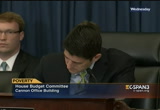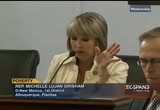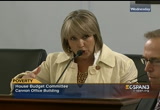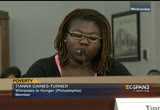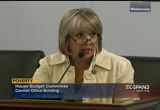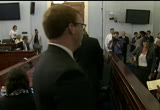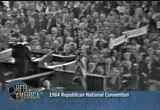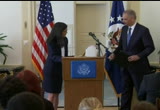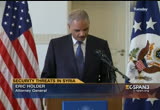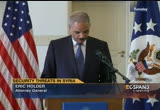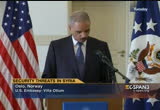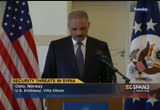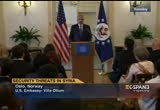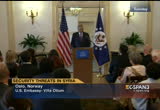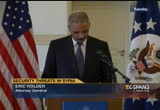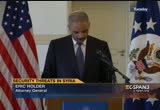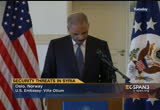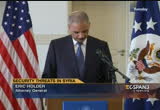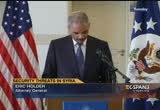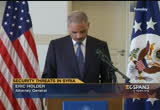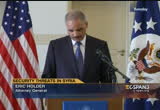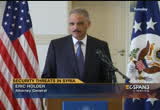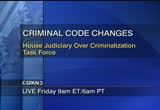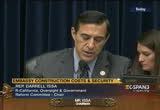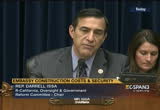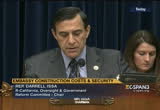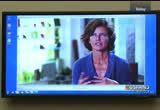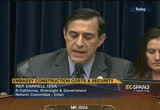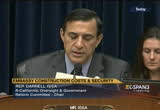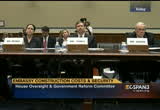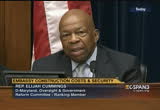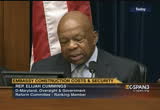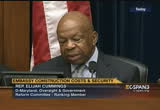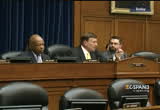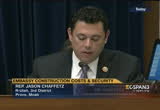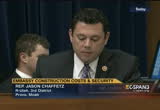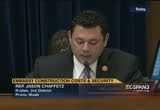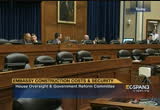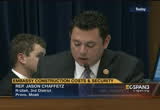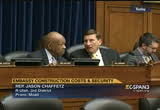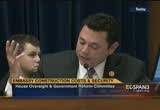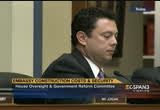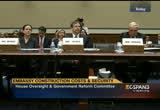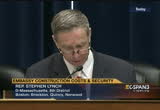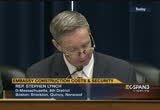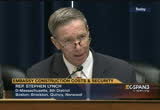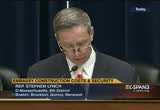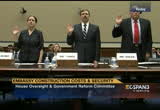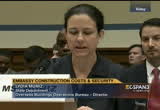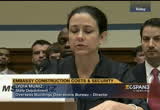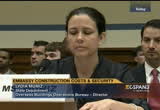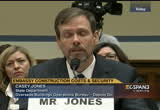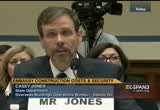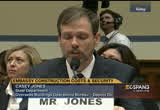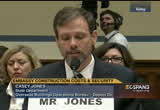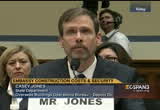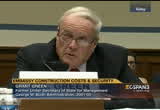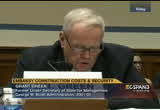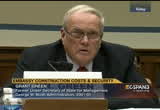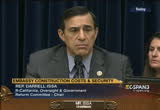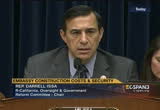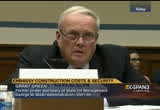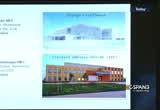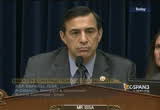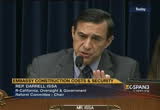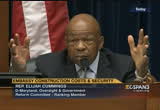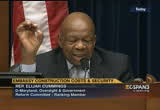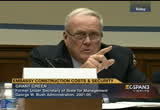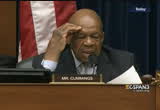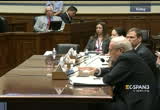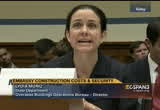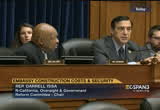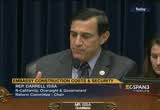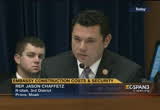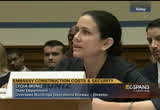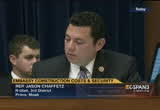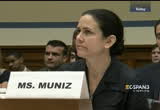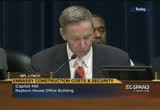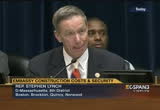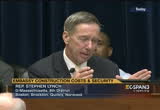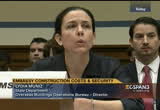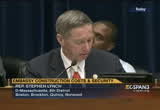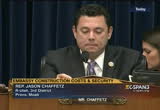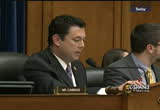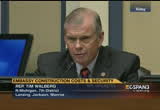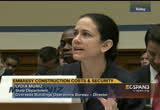tv Key Capitol Hill Hearings CSPAN July 11, 2014 1:00am-3:01am EDT
1:36 am
later, remarks by attorney general eric holder on addressing security threats in syria. next, a hearing on the cost and security implications of the state department's new construction model for u.s. embassies abroad. this hearing of the house oversight and government reform committee is 3 hours and 10 minutes. >> the committee will come to order. today's hearing examining new embassy construction questioning our new administration policies putting americans overseas in danger. the committee on oversight and government reform exists to protect two main principles. that the money washington takes from the taxpayers is well spent. and effective government that works for them. our duty on the oversight and
1:37 am
government reform committee is to protect these rights. our solemn responsibility is to hold government accountable to taxpayers, because taxpayers have a right to know what they get from their government. it's our job that we're tirelessly in partnership with citizen watchdogs to protect these rights, and to deliver the facts to the american people, and bring genuine reform to the federal bureaucracy. this is our mission statement. today we are examining the results of a department of state 2011 decision to transition from a successful program of standard embassy design, which stresses security, functionality, to a new undefined, loosely defined design excellence program which has led to untimely delays in construction as well as increased costs. these delays put american diplomats and their staff in an unnecessary risk.
1:38 am
keeping them safe should be our primary priority. in response to the 1998 east africa embassy bombings, the state department implemented sweeping reforms in the way it constructed new embassies and consulates overseas. among these reforms are the development of a standard embassy design that could easily adapt for size and location. the use of design built contract delivery method. the implementation of performance management and strategic planning principles. these reforms produced an impressive record of successful overseas facilities, construction, leading to embassies and consulates being well built, on time and on budget, and offering superior security. in 2001, the government was only building an average of one new embassy per year. one new embassy means 200 years
1:39 am
to replace all our embassies. and consulates. by comparison, in 2006, following the implementation of the new reforms, the state department bureau of overseas building operations, known as obo, opened an unprecedented 14 new facilities. that same year, the independent government accountability office, known as gao, found that the construction time for embassy projects had been reduced from 69 months, basically six years nearly, to 36 months, three years. in addition to reducing the amount of time required to build new embassies, gao also found that the majority of standard embassy design projects it reviewed ended up costing significantly less than state department cost estimates. the embassy construction program with standard embassy design at its core went on to move a total
1:40 am
of 32,000 overseas employees into secure facilities by 2013. starting in 2011, however, the state department decided that a working and efficient program wasn't good enough. and although they will report that they maintained these tools in their toolbox, they've gone to a program known intermly as design excellence. state maintains that the new initiative will incorporate a success of standard embassy design, while allowing for more flexibility to adapt its buildings to unique environments. in reality, however, the committee has learned that under the current management obo, has decided to transition away from standard embassy design program, in favor of a unique architecturally sophisticated and more expensive embassies.
1:41 am
embassies look better, and cost more. through this move, this may be visually attractive. the new design process does not prioritize security, it prioritizes appearance. the new standards view security and safety as something that must be designed around and disguised rather than the first priority. i'm now going to play a short video featuring architects, that was produced by the state department about the design excellence program. please play the clip. ♪
1:42 am
>> within that, we find different ways by which we can disguise the lines of security that are so crucial. >> i think the very first thing you have to do is make a building that actually doesn't feel hostile to its context. it has to really work with its context, and welcome the population there. >> balancing the security and the openness, that's one of the most exciting challenges. i think those are the kinds of things that good architects, great designers can do. they can do both things. security and openness. >> i'm sorry to have to say this. but were our diplomats in benghazi murdered because their building felt hostile in its context and didn't welcome the population there? they were vulnerable because they were in a non-standard,
1:43 am
non-secure building. a building in which the refuge point was not designed safely, and chris stevens died likely of asphyxiation as a result of buying, renting an off-the-shelf facility for a consulate safety facility. did americans die in the african embassy bombings because the buildings didn't do enough to have enough openness and balance of security? are disguising security measures really a good strategy to deter terror attacks? in the post-september 11th world, is it disconcerting to hear state department pushing these arguments. the answer is yes. in may of 2013, an internal state department panel on diplomatic security organization and management which arose out of benghazi's review board
1:44 am
recommendations, issued a final report. in the report, the panel, which was chaired by former undersecretary for management here today, grant green, raised concerns about design excellence program. the panel found no evidence for a business case or cost benefit analysis supporting design excellence program. the panel also expressed concern that under design excellence, fewer facilities can be built over the same time frame which could leave u.s. government personnel exposed for longer periods of time. losing momentum in construction of new or more secured facilities on time, and at a reasonable cost, would leave u.s. government employees in harm's way, and expose taxpayers to unnecessary fiscal risk. obo received $2.65 billion in fiscal year 2014 for embassy
1:45 am
security, and construction and maintenance. a significant increase over prior years. but how many embassies you build is how many large a figure you divide into that amount. when the department requested and congress granted a budget increase, it was based on stated need to construct new secure facilities, not to produce more architecturally pleasing ones. today we are conducting oversight of the state department's design program. though we have made meaningful and very specific document requests to the state department to date, the department has delivered -- has not delivered a single document. and this is unprecedented. today we are -- we are today here to examine whether obo has proper management and program in place to preserve the tremendous gains made under the standard
1:46 am
embassy design program, in securing u.s. diplomats and their families overseas at a reasonable cost. in closing, you are not the people responsible, but people who are listening today and watching today at the state department understand they have stonewalled our request. they have even used mail to disguise -- ordinary mail to disguise and delay responses. and this is contemptible. this is serious oversight of the congress, over the very lives and safeties of state department employees. this committee is reaching the end of its rope, which state department is stalling. you stalled on benghazi. and two years after the tragic death, we only learned that in fact state department was complicit with the white house in attempting to disguise a false narrative as to how and
1:47 am
why the consulate was attacked. you were not the messengers that will be shot, but understand, you may very well be back again and again as the documents that were requested finally come in. for that, i am truly sorry that you may come back here again and again. but if we do not receive documents that were requested in plenty of time, then much of your testimony today will be a first round, and not in fact the definitive oversight that we expected to have. with that, i recognize the ranking member for his opening statement. >> thank you very much, mr. chairman. thank you for holding this very important hearing. and i thank you, all of our witnesses, for being with us today. the bombings of our embassies in kenya and tanzania in 1998 were a watershed moment for our nation.
1:48 am
following those attacks, the state department reported that 80% of its overseas facilities did not, i repeat, did not meet security standards. congress authorized billions of dollars to expedite embassy construction around the world. as part of this effort, the state department's bureau of overseas building operations launched the standard embassy design initiative to promote the use of standardized designs for small, medium and large embassies. this program has been very successful in achieving its goals. since the year 2000, the state department has constructed 111 new buildings, and more than 30,000 u.s. personnel into safer facilities. the program also has its limitations.
1:49 am
the program, for example, it typically requires large parcels of land, which sometimes result in buildings being constructed further from urban centers. critics contend that this impairs u.s. diplomatic efforts overseas. it makes it harder for officials to conduct their work. as one commentator noted, the standard embassy design initiative was, quote, an expedient solution to an urgent problem, the one that narrowly defines an embassy as a protected workplace, and overlooked this larger representational role, end of quote. so we commend the tremendous progress made under the standard embassy design initiative. but we must always ask whether we can do more. we must ask the question, whether we can do better. on this committee in particular, we must ask how to make this
1:50 am
program run even more efficiently, and even more effectively. to me, there are three basic factors we must consider. one, security. two, cost. and three, function. in 2011, the department launched a new embassy construction effort called design excellence. as i understand it, this effort aims to provide the same, or better security, at the same or lower costs, while improving the ability of american officials overseas to do their jobs. this program seeks to achieve these goals by being more flexible than the current program. for example, by incorporating more customized designs rather than standard designs, the department may be able to build on smaller or irregular lots. this may allow more embassies to
1:51 am
be located in urban centers, and improve the effectiveness and efficiency of our missions. these more flexible designs also may reduce costs, lower initial construction costs and long-term maintenance costs. for example, the new u.s. embassy in london, although not constructed entirely under this new design excellence concept, shares many of its principles. this new facility will be more secure than the existing embassy. it will be more functional, and effective for our diplomatic missions. it will be completed on time. and it will be built at no cost to the united states taxpayer. this entire project is being funded through the proceeds of sales from exist iing propertie there. the challenge with this program, however, is the lack of data.
1:52 am
no embassies have been conducted to date based entirely on this new concept. the new embassy in mexico city will be the first facility constructed from start to finish under this initiative, but it will not be completed until 2019. according to mr. green, who is testifying here today, the department has not put together a comprehensive business case that analyzes the potential costs and benefits of this new program in detail. we all know that what can happen when the lack of adequate planning, under the previous administration the new embassy constructed in iraq went wildly overbudget, came in well after the deadline, and was plagued with corrupt contractors. it ended up costing the american taxpayers hundreds of millions of dollars more than it should have. and that money could have been
1:53 am
used to secure other u.s. facilities and american personnel throughout the world. so, as we evaluate the merits and drawbacks of this new effort, we must keep one goal at the top of our list. the security of our diplomatic officials serving overseas. mr. chaffetz, who serves as the chairman of the national security subcommittee, has asked whether this new initiative to customize diplomatic facilities, could delay their completion. in other words, if customizing is slower than using standard designs. does that keep our people in harm's way longer, as they wait for new secure buildings. i believe this is a legitimate question, and a legitimate concern. i want to know from the department what their answer is. our diplomatic officials deserve the safest embassies in the world.
1:54 am
and they also deserve facilities that help them conduct u.s. foreign policy in the most effective and efficient manner possible. i truly believe that every member of this panel feels the same way. and with that, mr. chairman, i anxiously look forward to the testimony of our witnesses, and i yield back. >> thank you, mr. cummings. i'm pleased -- >> mr. chairman? >> yes? >> prior to that, can i ask consent to introduce into the record a number of items? >> without objection, at this point, do you want to go ahead and state your -- >> i'd like to introduce into the record the gao report on embassy construction dated january 2001, another gao report from november 2004, regarding embassy construction, an additional gao report from june of 2006, about embassy construction, the july 2010 gao report, new embassy compounds.
1:55 am
i'd also like to enter into the record a letter that chairman issa and myself sent on june 23rd, 2014, to secretary kerry, requesting a series of documents that we have not yet received. i'd also like to enter into the record the response from the state department dated july 3rd, which we actually received on july 8th of this year. and then the final document is the u.s. department of state bureau of overseas building operations fact sheet, cbs news, are u.s. embassies becoming too costly to build. a response to a couple news programs. i'd like to enter that fact sheet back into the record as well. >> without objection, a request is agreed to. and now i'd like to recognize the gentleman from utah for an opening statement.
1:56 am
>> thank you, mr. chairman. i want to be clear. this is beginning of a series of hearings that i think are essential to figure out and get to the bottom of the truth of a situation that is -- thousands of americans are facing with their mission and their service overseas. the bureau of overseas buildings operations corps mission is to place americans overseas in as safe and secure facilities as fast as possible. i would note for the record that the state department budget, overall state department budget since fiscal year 2008 has increased more than 58%, going from $17 billion to over $27 billion. and that security funding from fiscal year 2008 to fiscal year 2014 has increased more than 100%. prior to 2011, and design excellence, the bureau seemed to be fulfilling its core mission, constructing secure overseas
1:57 am
facilities. they were doing it on time and on budget. yet in 2011, obo decided to take this rare government success story and replace it. the new program focuses instead on constructing fancy buildings to enhance the u.s. reputation around the world, all the while many americans are still waiting for their new secure facilities. the design excellence, the bureau subscribed to a view that fancy buildings equal successful diplomacy. that officials serving overseas, those whom they serve, care first and foremost about aesthetics, and that aesthetics alone can further u.s. diplomatic relations. since the bureau initiated the major overhaul of the overseas construction program three years ago, embassy construction has slowed significantly. while construction costs have skyrocketed to millions over price tags. long awaited facilities and less than secure cities have been delayed for years, while american officials overseas who devote their lives to furthering u.s. interests abroad must remain in undated insecure
1:58 am
structures. earlier this year, i traveled to new guinea, where i saw firsthand the new design initiative. there i saw an embassy construction project that was originally slated to cost $50 million. yet this is ballooned to a price tag of more than $200 million. all in the name of aesthetics. during my short visit, there was an attempted carjacking of an embassy staffer. this event along with my conversations with foreign service officials stationed there allowed me to see firsthand that having a fancy building is not high on their list of concerns. no one told me, quote, what we really need is a building that represents innovation, humanity and openness. they wanted a facility that offered safety and security for themselves, their families, and many visitors. why the department allowing foreign service officials to remain in unsecured dilapidated facilities at the price of aesthetics is beyond me.
1:59 am
we had a mission there who was trying to secure his people. they're in an old bank building. it is not secure. those poor people work in an office, they have to have an armed guard take them from their living facilities to the embassy itself. the facility that by any standard is not properly secure. in a may 2013 internal state department panel, a diplomatic security organization which was chaired by former undersecretary grant green, issued the final report. the panel found no evidence of a business case or cost benefit analysis supporting design excellence. in short, the program is yet to produce results, but introduces significant risk to constructing facilities on time, on budget, while moving officials overseas into secure facilities. despite requesting -- and to my ranking member and my colleagues on the other side of the aisle, we cannot do the work on either side of this aisle unless we get
2:00 am
the documents and operate from the same set of facts. we issued a letter, the third week of july -- i'm sorry, the third week of june, asking for a series of things. in preparation for this meeting. i have been working with the state department for months. they've known that i've been curious about this. i've traveled overseas. i've visited a number of facilities. yet despite that, we have not received a single document. i've got one page that said we will get this to you as soon as possible. and if you look at the document request, to have nothing coming into this hearing, is inexcusable. how can you provide us nothing. we don't have documents that mr. lynch, or mr. welch, or myself, or mr. walberg can look at. how can you do that to the congress? it's a waste of time and money and effort. and we'll bring you back. we'll do it again.
2:01 am
but you cannot come to the united states congress when we ask you for these basic documents and provide us nothing. our staff worked with you and said, if you have problems with one or two or three of the documents, whatever, just give us on a rolling basis what you have. and we got nothing. and i think on both sides of the aisle, that's a fair criticism. i hope my colleagues on the other side of the aisle also will help us with that. >> will the gentleman yield for one second? >> sure. >> i agree that -- and i'm hoping, mr. chaffetz, that the witnesses will provide us with reasons as to why we have not gotten what we need. you're absolutely right. in order to do oversight, we have to have documents. so i yield back. >> i thank the gentleman. let me give you an example. one of the documents is the report on diplomatic security organization and management. it's on the al jazeera website.
2:02 am
our own state department won't give it to us. i printed it out on the al jazeera website. why do i have to go to al jazeera to get the information that you have? and that you're withholding from congress? i yield back. >> thank the gentleman. let me recognize the gentleman from massachusetts, mr. tierney. i'm sorry, mr. lynch. >> we all look alike. >> mr. tierney is the ranking member, he's not here of the subcommittee, but mr. lynch is here. and you're given five minutes. >> i'm sure mr. tierney would take offense. >> i'm sure he would, too. you're much better looking. >> thank you, sir. i appreciate the gentleman's courtesy. let me just say to begin with, we really do need to have prompt, accurate response as an oversight committee regarding these matters. it helps no one to have the allegation of obstructionism
2:03 am
cast back and forth here. so i think that some of the gentleman from utah's complaints are well founded. about the responsiveness of the state department to our request. so we need to do better, okay? and that's from everybody up here. this committee is coming up on too many instances where it has been a long delay in providing information. things blow up. and then it looks like you're being less than honest, and less than forthcoming. at least with respect to the conduct of this committee. i will say that like the gentleman from utah, many members on this committee, i've spent a lot of time at embassies in some of the tougher spots around the world, and we've had an ongoing debate about how to
2:04 am
secure the personnel at our embassies. and it's a difficult problem. i don't think there's any cookie cutter approach to this. and i know that there was an earlier -- before the more creative design initiative was adopted, we also had during the 110th congress, this was during the bush administration, we conducted an extensive investigation to report the rampant waste, fraud and abuse around the construction of the new embassy compound in baghdad, iraq. and i've spent many nights there. the old embassy, the new embassy. that was a huge expense. going to be very difficult to staff. it's got more staffing requirements than the white house, to be honest with you. i think 3,400 people as opposed to 1,700 at the white house. it's just -- you know, it's just unreasonable to expect that that
2:05 am
is suitable to our requirements in baghdad. you know, we've had situations in yemen. i'm happy to hear that -- and when i was there, we had reconstruction efforts and strengthening efforts there in yemen with good cause. we had fruitful discussions up to a point with the syrian bashar al assad about relocating our embassy there in damascus. we don't have it there anymore, it's not staffed. we have to get around to relocating that. it's too vulnerable to car bombs, right there on the main street. and i do support having a more remo remote -- not necessarily remote, but a little bit of a setback for our embassies in and around the world. and that goes for not only
2:06 am
damascus, when we eventually get back in there, but also beirut. but there's been a profound lack of oversight in the construction process of one of the things i used to do. you know, i was a construction manager. and that's what my undergraduate degree is in. so i've had an opportunity to see how we're going about this. and there is -- to put it bluntly, there is great room for improvement here, in terms of how we're going about spending this money, and the -- as i said before, the sort of cookie cutter way that we've tried to approach this in the past. i'll be very interested in your answers to a number of questions regarding some of these arrangements. i know that in the case of the baghdad embassy, we had $130 million plus in questionable charges by the first kuwaiti
2:07 am
corporation that was allegedly engaged in a $200,000 bribery and kickback scheme in order to obtain subcontracts. we've had flagrant oversight lapses on the part of the state department, that had been previously warned by the defense department audit agency. and it's just been a series of missteps on our part. and underlying all of this is just a new world out there in terms of the risk to our people in these embassies. ben dpauzy is one example, although that was not an embassy. still, it -- you know, it shows us what can go wrong. we have a real obligation here to reassess the defense protocols that we have at our embassies, and that obviously includes how we're building them and what kind of apron of security that we provide for these facilities.
2:08 am
so we've got to get smart about this in a big hurry. we've got to be more effective with our architectural design. and we've got to be much more wise with the expenditure of taxpayer money in support of these efforts. we can't afford to fail. with that, mr. chairman, i'll yield back. >> i thank the gentleman. i thank him for his important comments. the and mr. lynch, i thank you for your being a willing traveler to tough places over the years. you and i have had the privilege of going to some of those places. >> thank you. >> we now welcome our witnesses. miss lydia muniz is the director of the bureau of overseas building operations at the united states department of state. and again, obo as it's known. mr. casey jones is the deputy director of the bureau of overseas buildings and operations at the united states state department. and the honorable grant s. green
2:09 am
jr. is the former undersecretary for management at the department of state. lady and gentlemen, pursuant to the committee rules, would you please rise to take the sworn oath. and raise your right hands, please. do you solemnly swear or affirm that the testimony you are about to give will be the truth, the whole truth, and nothing but the truth? please be seated. let the record reflect that all witnesses answered in the affirmative. in order to allow sufficient time for questioning, and answers on both sides, i would let you know that your written statements are already part of the record. and so please use your five minutes either to read a portion of that, or to other comments as you please. ms. muniz? >> thank you. chairman issa -- >> and i must tell you, these mics really want them closer to you, rather than further away. if you will pull it
2:10 am
significantly closer, it will make it easier. thank you. >> chairman issa, ranking member com, and committee members, i appreciate the opportunity today to discuss the state department's program to build safe and secure facilities. for u.s. government staff serving abroad. i'm lydia muniz, director of the overseas building operations. i've been with obo since 2009 and came to the department with nearly 20 years of government and real estate development experience. the state department is deeply committed to the safety and security of our personnel overseas. every new construction project that obo undertakes must and will meet the security and life safety standards required by law, which our colleagues in the bureau of diplomatic security, and by obo. security is the cornerstone of our building program, and because we have an obligation to the american taxpayer, to be efficient in constructing our facilities, we're committed to ensuring we neither compromise the speed in which we can
2:11 am
deliver safe facilities, nor incur unjustified and unnecessary costs. obo facilities serve as the overseas platform for u.s. diplomacy. they provide access to consular services and ensure food and product safety and implement programs critical to our national security interests. since congress enacted the secure embassy construction and counterterrorism act, or seca, in 1999, obo has with the continued support of congress completed 76 new embassies and consulates, with 16 more under design and in construction. we have moved over 31,000 employees to more secure facilities with plans to move another 14,000 within the next five years. after ten years of a successful building program, we examined our work, and instituted the initiative that deployed the lessons learned over the years. this includes the requirements of the missions abroad, most
2:12 am
critically safety and security. but also durability, efficiency, flexibility, proximity for personnel and visitors, and a platform that serves the needs and mission of america abroad. we know that security, safety and excellence are mutually reinforcing, not mutually exclusive. the standard embassy design standardized facility requirements and the way in which they were met and created a discipline within obo to deliver those facilities. using the standard embassy design, obo came to better understand the common requirements of missions like consular sessions and specialized office space. we also learned that while embassies and consulates have things in common, they also vary widely. their missions in dense urban environments and in rural areas, posts with as few as three staffs, as many as 2,500, some have sections with one windows, others have more than 100. so while the s.e.d. provided
2:13 am
consistency, they need to meet the needs of the mission and deploy taxpayers dollars in the most effective manner. we learned we should take into account local conditions and materials in order to have buildings perform better in the long term and consider not only first costs, but long-term operating costs. and we recognized that our facilities not only meet the functional requirements of our missions, they represent the united states to the rest of the world. our embassies are the most america that many who live around the globe will ever see. at a time when it is increasingly important, that we provide for the security of our citizens at home, through diplomacy and engagement with people around the globe, embassies that convey u.s. values, culture, strength and know-how can be instrumental in that effort. all of this can and must be done meeting all of the department's security standards and without compromising on schedule or cost. we must protect our staff abroad, and using the lessons
2:14 am
learned over the decades, we can design and build embassies and consulates that serve our missions and value to the taxpayer and make better use of scarce resources, in the short and in the long term. i would like to thank congress for their consistent support of obo's building program, including an fy 2013 providing increased funding to help our program keep up pace with inflation. in these uncertain times, we know that our facilities must keep our staff safe and secure. the excellence initiative will ensure that. we'll meet the needs of our missions and provide the best value to the american taxpayer. >> thank you. mr. jones? >> good morning, chairman issa, ranking member cummings, and members of the committee. thank you for the opportunity to appear before you today. i am a deputy of director in the overseas building operations in the u.s. department of state and have served in this position since october of 2013. the safety and security of the
2:15 am
individuals who work for the u.s. government agencies overseas in creating and maintaining safe and secure facilities in all parts of the world is critical to the department. i know firsthand the reality of living in a high threat environment is part of a foreign mission. as a child, i lived in pakistan through periods of martial law and civil unrest. we lived on the grounds of the embassy returning to the united states months before it was stormed in november 1979. this experience had a profound impact on me. security has been obo's top priority since the 1998 bombings of the american embassies in salam and nairobi. obo executed a successful building program utilizing a standard embassy design. this work is now being enhanced by our excellence in diplomatic facilities initiative which will build the next generation of safe and secure facilities. i want to assure you that the excellence initiative does not diminish the safety and security
2:16 am
of new embassies. every office within obo, real estate, design, engineering, construction, facilities cost and security was involved in developing the initiative. as well as collaboration with other bureaus in securing diplomatic security. briefings on the improvements were provided to the department, congress, and the industry at large. the excellence initiative is about constructing cost-effective buildings, buildings that meet all of the requirements for our mission, safety and security chief among them, flexibility and efficiency. ds and obo worked together throughout planning, design, construction, and day-to-day operations of diplomatic facilities. i also want to assure you that the excellence initiative does not lengthen the delivery time of new embassies and consulates. obo uses two common delivery methods for its projects. both methods have time, cost, design control and risk
2:17 am
implications. that must be evaluated. the choice of which to use depends on the unique conditions of the building project. under excellence, obo will utilize which method is most cost effective, expedient and reduces the most risk. i want to assure you that excellence does not increase project budgets of new embassies and consulates. obo salvaged the project budgets whether for excellence project or standard embassy design, that are based on scope, local conditions and prior cost information. obo has a depth and breadth of data that allows us to be very accurate in setting project budgets for new, safe and secure buildings. obo cannot anticipate every potential impact. real world events, unforeseen cost increases in materials, civil unrest, currency fluctuations and natural disasters can affect our projects. we are also not immune to policy changes. if the u.s. government decides it's in the nation's best interests to significantly
2:18 am
increase or decrease the size of a mission, or change the functions located at a post, the cost of our projects are impacted. sometimes significantly. an example of this is the new embassy compound in por morrisby. in 2011 obo awarded a contract to build a standard lock and leave embassy. in spring 2013 with construction well under way, the u.s. government made two policy decisions that significantly changed the project. first, a marine guard detachment was added and second, staff population was increased by almost 75%. the cost benefit analysis conducted by obo concluded that the additional requirements could not be accommodated in the existing contract. without incurring an additional $24 million over the scenario. as a result, obo stopped the remaining work, and will recompete a modified project with the additional requirements. this option utilizes but has already been built on site and
2:19 am
yields the best end product. continuing with the contract as is would not have provided safer, more secure facilities any faster. as deputy director at obo, i want to emphasize that i take the responsibility to provide safe and secure facilities very seriously. and that there has not been nor will there be a move away from that critical mission. diplomatic facilities are an essential function of our national interests. the individuals who represent the u.s. deserve safe and secure workplaces. and as good stewards of taxpayer dollars, it is our goal to see that those resources are invested wisely. thank you. >> thank you. mr. green? >> mr. chairman, members of the committee, i'm pleased to be here this morning to respond to your questions related to embassy security. my background, part of which has
2:20 am
been mentioned, i served as undersecretary of state of management for four years under colin powell. i subsequently served as a commissioner on the commission for wartime contracting in iraq and afghanistan. and most recently, chaired the panel that's been talked about here, which looked at the management and the organization of diplomatic security. this panel grew out of the accountability review board following benghazi that was chaired by admiral mullen and mastery pickery. as we on the panel progressed with our deliberations, we looked at one thing, and we looked at many things, but one thing we looked at was the relationship of diplomatic security to other bureaus and
2:21 am
organizations both within the state department and across the government where appropriate. obviously obo, a close partner of diplomatic security, was included in that. as we talk to many ds employees, and others who are familiar and certainly concerned with security issues, it became evident that they had security concerns with certain aspects of design excellence. we can -- you know, we can talk about the importance of security. the president includes in his letter to all chiefs the submission. secretary kerry has stated publicly that that is his most important mission is to protect the people working for this country overseas. but when we hear from people who
2:22 am
are close to ds, obo operations, and they have voiced concern, then we were concerned. and as a result, we came up with a number of observations, and a recommendation. it wasn't to throw the baby out with the bath water. it wasn't to say, do away with this crazy scheme. and go back to standard embassy design. all we said was, state department, you need to take an in-depth look at the security implications of this program. so with that, mr. chairman, i conclude my opening remarks. and i'd be happy to answer any questions. >> thank you. ms. muniz, i just want to go through briefly one embassy not including the ones that were primarily here.
2:23 am
on a bipartisan basis, with staff on both sides, i went to london and i looked at the facility there. and we understand that's an iconic facility. the justification for a glass curtain wall building. and a stunning appearance. and even a moat. it has a great deal to do with our relationship with our most close -- perhaps our most close ally, is that correct? >> yes, i think that's accurate. >> it's not part of the standard design, or design excellence, it has its own purpose? >> that's correct. >> let me ask -- would you turn your mic on when you answer, please? >> yes. >> but i have one question. which is, do you believe that it is a good policy for congress to ever say, you can spend all that you get from the sale of other buildings, not a penny more, and no encouragement to spend a penny less. that's really a yes or no. do you believe that is a good
2:24 am
poli policy? because that's what they're doing there. >> i think that -- i think that, as you noted, london is unique. >> i know, but i really want the yes or no, because i want to get on with the rest of the time. the congress made a decision and state department is spending every penny adjusting up or down based on how much money they have, they're spending every penny they got from all the revenues on there. they're not spending any more because they're prohibited by congress. but they're not spending any less. do you believe that is an appropriate way to design any building? yes or no, please. >> i can't answer yes or no. these are unique circumstances. >> ma'am, yes -- no. my time's limited. do you believe that that is appropriate doing it that way? first of all, do you disagree
2:25 am
that that's what they're doing, they're spending exactly what they got from the sales, yes or no? >> they're spending marginally less. there should be income coming from the proceeds of the sale back to the government. >> i wish that was so. that was not the report we got on a bipartisan basis less than two weeks ago. i'll consider that you're not going to answer the other question yes or no. but i'll answer it for you. no, it is not appropriate to say, spend all the money you can get. they could have spent $200 million less, and we could have built two other embassies. if they needed $200 million more to do it right, we should have considered that and made a request. that is not how the it is not a part of it here. mr. green, basic, basic question that you found in your study. standard embassy designs have a certain look which have been modified quite a bit. is it fair to say that what they
2:26 am
look like to a great extent is like -- industrial commercial office buildings all over america. what's commonly called class b or concrete tilt up buildings that are made to look nice but they're ultimately fairly industrial? >> i don't think so. i think when -- when we adapt the facade of a building, the goal there was to fit it in with the -- with the culture, the country, to make it -- as -- as unattractive as we possibly could. and in my time at the department i visited more than 100 of our posts overseas. >> how about -- how about -- >> about which? >> prekinofasso?
2:27 am
>> scan we put one of those up. it is important. quite frankly design excellence seems to be pretty look. see the two buildings. now, the state department hats not given us any of the information for us to evaluate the cost per desk or anything else. which makes it very hard to do some of the assessment. but your study shows us that they're not cost justifying the building on the top is, is made with nonlocal materials that are only made tlin plain three place world. this concrete facade. it clearly is an architectural design rendering to a great exte extent, not necessarily all functional. not a standard build. it costs a lot of money. and it is an area in which there are more security guards than there are embassy personnel at desk. it is a high-risk area. is that justified versus a standard built in your opinion. if i need 550 people to provide
2:28 am
security for 400 embassy personnel, do i in fact have a place in which the priority should be i'm looking pretty for the population so that they can be happy with us? >> not in my opinion. >> security, if it takes 550 people to protect 400 people is that a place in which there is any question about what the priority should be? >> priority is -- has got to be security. in the department there is always this are gaumegument whe be with embassy construction or anything else. or housing for example. we used to have those who would say, we need to be out in the community. we need to live it out in the community. i don't want to live out there because of the hazard. i want to be on a skom poucompo.
2:29 am
if you pin people down, security is most important to them. >> let me ask a closing question, i have picture after picture, cost after cost, we'll have some people back here when the state department delivers the arithmetic so we can evaluate it. i know you were above the folks here so. you oversaw people doing the jobs of, monets and jones. from a construction standpoint. from what you were trying to achieve. during your tenure weren't we eventually making a decision to cut out architectural fees and changes that made embassies dissimilar versus similar? >> i don't know that we were trying to make embassies similar. but we were trying to stay within a fixed amount of money so we could build as many embassies as we could to get as many people out of harm's way as we could. if they weren't as beautiful as -- as some body might like,
2:30 am
that wasn't the main factor. the main factor was get embassies built. as you mentioned -- there were -- after the report, after the beirut bombing, we had 120-some-odd embassies that were rated unsatisfactory. and what we want to do was -- was get as many of those fixed as we could. and -- and, you know, i have, as i said, i have been to 100 of our posts. all of them beautiful? no, they're not beautiful. i think, in fact i opened the embassy in nigh rairobi, and th fine. >> i want to give you a chance to answer. but i want to get two things into the record. first of all, the pretty biflding on tbifld i building on the top is in the 19th most dangerous priority area. an embassy need to be built sooner rather than later in
2:31 am
which security its clearly one of our greatest concerns. secondly lly i want to mention trip to britain was interesting, in that the ambassador and went through and explained how all of the embassy was and how we needed to replace it. he reminded me the disfunctional building was designed by the man who designed dulles airport. at a time when gorgeous buildings were in the modernist eye of beholder. that we were building them all over the world. in fact, design sx lenexcellenc like a designer's suit it ages more quickly than the industrial look. if you had any other answers. i wanted to mack sure i gave you the opportunity. >> thank you, mr. chairman. what i would look to add, go back to really when talking about this project is that as my colleague, casey noted. we base our budgets on the
2:32 am
embassy budgets. number of desks, the distance to get materials, we fix that budget and we work within that budget. so the building that you see that might be more attractive, might be more tailored to the missions in question -- >> when we have the numbers d - drn --- >> would cost no more. >> when we have the numbers. we can have the discussion. since the state department has refutzed to comply with a lawful request for any data. even one shred such it. we only have, if you will, sort of the whistle blowers side of it. we don't have your side. but i will say that, to fly in concrete from europe for the top building to me is a questionable item that i am going to want to see why those materials were chosen over materials that could be provided more locally. mr. cummings. >> thank you very much, mr. chairman. as i am sitting here, i want us
2:33 am
to, to -- to take a deep breath. and focus on, what you said, mr. green, security. when all is said and done -- a lot of these buildings will be in existence when we are dead and gone. and this is our watch. we have a moment in time right now to get this right. not just for -- for our present diplomatic corps, but for generations yet unborn. and i want us to stay focused. because i think we can kind of drift off and not zero in. that's why i think when mr. tavis' comments about the -- the data that we have asked for is so important. so that we can try to figure this thing out.
2:34 am
using the best information that we have. in the time that we have. so, with that backdrop, i want to go to you, and let me start by, you know, tavis' -- serves as the chair of the national subcommittee, raised a legitimate question whether new design excellence initiative to customize diplomatic facilities could delay their completion. mr. green you raise a concern in your report which said this, i quote, despite scheduled cost assurances from o.b.o., there is concern that fewer facilities, and you just said this is a minute ago too, embassies consulates can be built over the same time frame leaving more personnel exposed in, in that inadequate facilities for longer period of time. mr. green, can you elaborate briefly? and what are some of the
2:35 am
challenges with customizing versus using standard designs and you said, a moment ago that you didn't say -- throw the baby out with the bath walteter. you said certain recommendations. i assume that you were saying, look, we just want to be practical, to get back to that security thing, cost, function. so that we can be effective and efficient in what we are doing. so, could you comment, please, sir? >> sure, yes, sir. the observations that we made and this is -- in the report -- and certainly not all inclusive. we didn't, this wasn't six smart guys in the mess hall that dreamed these things up. these were based on comments we got from security experts who work with o.b.o. on a daily basis. i, i would tell you for one -- if you can build a beautiful
2:36 am
embassy under design excellence and do it as fast and it doesn't cost any more, i'm all for it. i don't care. i don't care what we build. but -- what i am concerned with, it's just not logical to the people we talked to and frankly to me, that you can -- build under design excellence as quickly and as cost effectively as we did under standard embassy design. you are going to pull a deseign off the shelf. build it. adopt the facade in a way that is -- fitting with the, with the local, the country. as opposed to going through a design bid build with architects and builders. it just doesn't make sense. now, if, if you can show me with
2:37 am
facts and figures that it does, i'll salute and -- and agree with you. >> there is one thing that you did not mention. i assume you meant to. function too. security, cost, function. you want nem to function properly too. >> yes, absolutely. and i think that, you know -- standard embassy design was, was -- a living, breathing thing. i mean there were reviews done constantly. and, sure, was everything perfect. no. no, the ceiling is too high. we can't put the lightbulbs in. well we don't have enough parking. or the medical facility is not large enough. and those -- those challenges were addressed period ekly and -- standard embassy design was modified accordingly. function is certainly important. and i think the director
2:38 am
mentioned, 100 consular windows versus one. that, that should -- and maybe that happened. but, that should be worked out as you're planning the design. in a certain country that says five consular windows aren't enough for us. and hopefully, within the budget, we can adopt that. >> what is your response, design sx lense program, will it delay embassy construction? >> my response is no. i need to go into detail. which can some times lose folks. if you would bear with me. we use two different methods to deliver projects, at obo, design build, and design bid build. some times we don't have advance notice. we need to turn around, go into tripoli, set up an embassy and move quickly.
2:39 am
but because our appropriation is regular it allows us to do advance year planning, very easily. what we are able to do. we know in any fiscal year we will do five embassies we designed before. because we are going to get under the initiative excellence, 100% designs. when we award the contract, the duration from award to -- cutting the ribbon and letting people into the safe, secure facility is actually shorter. because we will only be doing construction, we will not be doing design and construction after the award of the project. if we don't have a lot of advance notice, i, i think that we really do need to go back to design build and re-examine the type of build weg would ping wen place. i think what's great about this initiative and this approach. it will allow us not only to meet the same schedules but in cases to improve on them. >> now, would you have said that to mr. green?
2:40 am
what do you have to say to that, mr. green? >> i am not an architect nor am i an engineer. if obo contends they can build things as quickly. i may, may not question it. all i am saying is -- the folks that worked with o.b.o. on a regular basis questioned it. >> now, mr. -- ms. muniz, the previous embassy in iraq was build? before the department decided to design the sx lenexcellence pro. it was fraught with cost overruns, contractor corruption, this committee found in 2007, the project was delayed 16 months and the cost to the united states taxpayer was $144
2:41 am
million more than originally projected. so, the issue of delays and increased costs can occur regardless of whether the department uses standard embassy design, concept, or design excellence concept. would you all agree? >> i would agree. >> baghdad was kind of a unique situation. once, once it had been planned initially, then defense department wanted to put more people in there. so we had to modify the -- the size of it. i'm sure there were many, many other things that, i went to be there. i want 15 desks instead of three. it was a moving train, believe me. >> i think that's accurate. in fairness, as my colleague, mr. jones pointed out, we build in different environments. there are all kinds of things that our projects are subject to which can complicate delivery. the department, the country, can
2:42 am
decide to change the staffing pattern significantly and require us to modify. war. shortages. natural disasters can impact the schedules. so while i haven't looked at the iraq project in detail. i have looked forward since coming in to o.b.o. i think in difficult environments, as folks who know construction firsthand, those can have a real impact. but i do think that having a dialogue with congress, with our off-riders, this committee on such changes. people jnd staunderstand the ch can be helpful. >> as i close. i ask unanimous consent to enter into the record a letter sent to the state department on october 9, 2807, by the committee's previous chairman, henry waxman, describing the detail of the many flaws with the construction of the u.s. embassiembassien --y
2:43 am
in iraq in 2807. >> without objection, so ordered. if the gentleman would yield. >> congressman waxman did a great job of sxsx -- great job exposing, of vague ideas what they wanted at the beginning and ever changing was the best example of a bad example of how to build an embassy. ranging members made a good point. that's exactly what we don't want to be doing. >> thank you very much, mr. chairman. >> if i could have indulgence for 30 second. to follow up on the ranking member. mr. green, i just want to have the public understand something about the standard design. if we were looking, let's say, at the 737 aircraft. something most people have flown in. that are listening. they started making them in the
2:44 am
late 60s, early 70s. they're very different than today. a continuous design that any given time. they, the 737 is a standard built. would that be somewhat similar to how the evolution of standard built goes? is that what you build 20 years from now would be the standard would change over time. but the idea is to effectively have a continuously improving product, like a 737 boeing air kraf craft that everyone recognizes but keeps getting better over time. >> i think that is a fair analogy. >> and, that's the same idea. we all understand this is. not a fixed design. but an evolution of a standard build. thank you. >> i thank the chairman and thank you for holding the hearing. it is pivotal. ms. muniz, in response to a cbs morning news program and a "cbs evening news" program, state department was able to put out its fact sheet. they did produce those documents. again no documents produced to
2:45 am
the united states congress. in this, you say, all facilities will be delivered on the same, if not shorter schedules. there is no evidence to the contrary. do you have any examples of -- of a design excellence building that is coming in on time or, say shorter schedule, than standard embassy design. do you have any examples of any building that has been built for less than money, less than, the mun in money that we would have spent under standard embassy design. >> thank you for the question. as the committee knows the process to. >> no, no, no. i have five minutes. i got like 100 questions. do you have a single example of success as you have stated it? >> yes. >> which one? >> there are early excellence
2:46 am
initiative projects. there was one in 2011, one in 2012. >> i need the names of these facilities. >> we can submit that for the record and take a bit more time to go over all of those. >> hold on, i'm sorry. i have taken up a minute and a half. you're going to give us the names of these buildings and when will you give them to us. >> 2011. >> you said you want to submit them for the record. when are you going to give them to the congress? >> i could give them to you now. or leave it. 2011. 2012. 2013. those are early excellence initiatives. the first projects that will be awarded under the full initiative and the new standards are in fy 14. those are typically awarded end of the fiscal year. and they're all on budget and on schedule. we will provide additional data about those projects as soon as
2:47 am
those projects are awarded. >> let's go to, go to it for a second. i had a chance to go visit there in february. when was that originally slated to be completed? >> in 2014. >> may, 20, correct? >> yes. >> now when is it slated to be completed? >> early 2018. >> so they're having to stay in the same facility, exceptionally dangerous, correct? >> the reason it is on the vulnerability list and getting a new embassy is because it is dangerous. >> when did you get the final determination that marines were going to be located there? >> the embassy that is being built there is based on numbers provided in 2008. as committee members know the number and programs for embassies is not set by o.b.o. -- >> when did you get notification that marines --
2:48 am
>> we were awarded a contract in 2011. two years into the construction of the project we were notified that marines would be going to portmorisby and staff of 41 had increased by 31 including the marines that is a doubling of the size of the embassy. there was no way to continue with the project in a way that allowed us to deploy our resources intelligently. that would have allowed diplomating security to certify the building and co-locate all the staff. we made the modifications that were necessary based on real changes that reflected american priorities. >> i am going to try again? >> when did you get the official notification that you were get mag reasons? >> 2013. >> can you provide that to this body? >> yes. >> when will i get that? >> the department is part of that answer. we will provide that as quek lq as possible. >> this is the challenge,
2:49 am
chairman. >> if it is so dangerous, and they need marines, why aren't they there now? >> the deployment of marines is not something which is in o.b.o.'s per view, i would prefer that question back to d.s. we can get back to you on that. >> again, you have how to get back to us on it. >> tell me, what happened. that cost was going to be what? originally under standard embassy design it was going to be an expense of roughly $50 million was the projection correct? >> no, that is inaccurate. the $50 million is the construction contract only. the information that we provided to the committee and to the cbs reporter who reported on this it that the budget was $79 million. >> what 's the budget now? >> the budget is not yet reconfirmed. i think we will be closer to $200 million. >> it's not reconfirmed? what about this document here that i have that has initials on
2:50 am
it? it says -- will remain $211 million for this option. >> we believe that the cost will be under that. we are at 35% design. >> why? that is what was signed off on? >> that its not what was signed off on. that is not a final budget. >> we will go through that in further detail. i am past my time. i have a host of other questions, chair. >> i thank the gentleman. we go to the gentleman from massachusetts, the other, congressman. >> thank you, mr. chairman. again, i appreciate this. i know we are beating up on the state department a little bit. i do want to say to be fair that the state department did turn around an immediate request from the chairman last weekend to support a delegation to inspect the embassy in london. that request came in friday.
2:51 am
they left sunday. meetings and briefings were lined up for monday. usually, konl decongressional delegations are lined up for weeks. they should be thanked for helping the committee do the inspection. i would caution you and to your colleagues that, that have the authority to approve oversight oversight committee co-dels for inspecting embassies we need cooperation. we need cooperation right now in iraq. and i know you have limited resources. we have a responsibility here as the civilian part of this government to get in and mack sure that our folks are safe. so we need cooperation there. we need cooperation in yemen. we need cooperation in afghanistan. and so we understand very well -- the trepidation that you
2:52 am
have. this is a necessary part of our job. we need full qucooperation from the state department doing oversight. not just your job, it is also our job. we just want to amplify our need to get in and out of our countries as expeditiously as possible. and we apologize for any diversion of resources to ma ss that happen. if we are going to soon off on a budget. we need to know what the situation is on the ground. we owe that to the taxpayers. and also to the personnel that are in the facilities. so, enough of that. i do want to talk a little bit, ms. muniz about -- the drawback, i understand, you know, mr. chavez has an affinity for standard design. looking at it requires a parcel of land to set it down. this is the problem we had with bashir al-assad in damascus.
2:53 am
sort of downtown there. on the street. very exposed. we need to, we were frying, at that point, to try to get the set design configuration for the new embassy there. new location. there was nothing downtown. so we end up further out. that ex-poses us, even though we would have -- sort of, mr. chavez's idea of that set design with apron of security there. we would have to be further out, out of town. with a long commute for our people once they fly in. very much exposed getting to the embassy. the same problem we have had in afghanistan. the most dangerous drive in recent years when delegations fly into afghanistan. then yu have got to drive up that road through the circle to the embassy. they tried to tip my car over,
2:54 am
the rotary a while back. bunch of people very upset about some body flushing the koran down the toilet or something like that. the crowds just went wild. but so putting our people outen a -- out in a remote location is not the safest result for our embassy either. tell meet answer. how to configure this? you have not abandoned the set design. is that still on the table for when the lands s is available. awe thank you for the question. let me try to reply to it quickly. you make a great point. part of the difficulty of the standard embassy design is it was a largely horizontal solution. so that where land is abundant where we could be on that much property close and close proximity to our colleagues, so that we are not required to
2:55 am
travel back and forth, which has not only security, but, extensive cost implications. it made sense. in a lot of the cities we are required to build in now. not only not possible to find the 10 acres. if we were find it is it expensive. in london, we are building on less acres, 4.9 acres. property in london is very expensive. it makes a huge difference to be able to be on a smaller plot of land while still meeting all the security requirements including the legal requirement for 100 foot setback. but so both cost and security i think play. but it also gives us a lot of flexibility fee flexibility, building in all the locations where we need to build in. where ten acres may not be available. >> yeah, so what you are saying is, design excellence model gives you flexibility fee?
2:56 am
>> it absolutely gives us that flexibility. off awe ye >> yeah. all right. when i try to think about different locations, demand and environments that our embassies have to on -- operate in. gives me pause to come up with a one size fits all solution to that. which i think the set design more or less requires. i do support your ability to have modifications on that. more towards design excellence piece. but, you know, sometimes we do have -- what, what someone casual observer might observe as being, you know, far beyond what is necessary. so, you have to caution people on, on the cost aspect of that as well. i have exhausted my time. and i --
2:57 am
>> will the gentleman yield for a moment? >> sure i would. >> i believe there are multiple exam puples of standard embassy design on less than ten achers. one of the concerns, multiple g.a.o. reports, inspector general reports, that buildings were coming in under budget and faster. >> you know, reclaiming my time for a minute. you know the -- the baghdad embassy though, dear lord, that was $750 million. that was 3/4 of a billion. >> baghdad is not standard embassy design. >> modified. that's what it started out as. we have more than ten acres there. we have got, you know, so. ideal situation. all i'm saying, not just a question of one method versus the other. i think that -- you know -- whatever allows us some
2:58 am
flexibility to kconsider the situation on the ground would provide the best. i don't disagree with the points you are raising. i don't. i've don't. i just think it is so varied. the landscape under which the, the o.b.o. and state department have to operate they need that flexibility. all i'm saying. i yield back. >> the gentleman yields back. >> thank you, mr. chairman. thank you to the panel for being here. and you know i just opened my statement having had the, the privilege to, to travel to a number of embassies and consulates. in the regions of, great insecurity. my, my impression of our, of our public servants that are in those positions was enhanced increased almost, disbelief that some would take those positionings. we want to make sure they are
2:59 am
cared for appropriately. and mack sure the tke sure the cared for appropriately as well. and i would add my comments. requesting you convey to people who can get us documents that we have been requesting. it is so important. i have been listening to questioning already and fine disagreements on, a numbers, stiz figures things like that. because the we don't hatch the information. we can't do the work. i don't expect any hard drive to break down. i hope not. before we get that information. we really need that. and in your testimony, mr. muniz, and mr. jones, you talk about the development of design excellence. you talk how -- how working with them was a very participatory process within the state department. can you -- describe how the bureau of diplomatic security
3:00 am
participated in development of divine excellence. we know that works. but design excellence. >> your microphone. >> sorry. >> move that microphone up closer. >> i'm sorry. >> the foun daedation of the excellence it nesh tinitiative. base statement. we are not changing security standards. period. i have been in discussions with my colleagues and diplomating security at the highest levels and working level and made that assurance. i think that -- that is what is most important to them. and they have every reason to insist that that still be the case. >> did they clear -- on design excellence? >> they claeeared on our proces yes. >> who cleared? >> i would have to get back to you on the clearances. but again. how we put those
34 Views
IN COLLECTIONS
CSPAN3 Television Archive
Television Archive  Television Archive News Search Service
Television Archive News Search Service 
Uploaded by TV Archive on

 Live Music Archive
Live Music Archive Librivox Free Audio
Librivox Free Audio Metropolitan Museum
Metropolitan Museum Cleveland Museum of Art
Cleveland Museum of Art Internet Arcade
Internet Arcade Console Living Room
Console Living Room Books to Borrow
Books to Borrow Open Library
Open Library TV News
TV News Understanding 9/11
Understanding 9/11
